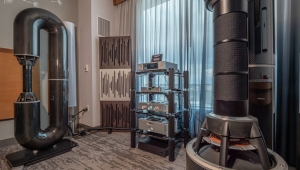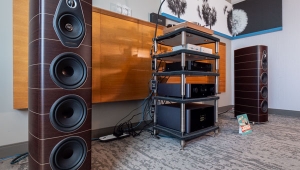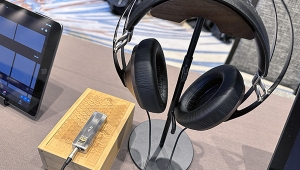| Columns Retired Columns & Blogs |
dCS 972 D/D converter 1999 Editor's Choice
Sidebar 3: 1999 Editor's Choice
(from December 1999, Vol.22 No.12)
(from December 1999, Vol.22 No.12)
In that repository of human wisdom, The Hitchhiker's Guide to the Galaxy, reference is made to the Babel Fish. Once you slip one of these prosthetic piscines into your ear, it translates everything you hear into a language you understand.
The beauty of "standards" is that people can choose whichever one best fits their needs, and in these days of multiple digital standards, the British dCS 972 digital-to-digital converter is the audio world's Babel Fish. It can take PCM datastreams of word lengths from 16 to 24 bits and at data rates from 32kHz to 192kHz, via one or more regular-speed or high-speed AES/EBU interconnects, through electrical or optical signal formats, and output the data in whatever format at whatever sample rate you wish. Along the way it monitors levels, reduces word-clock jitter, can adjust gain and polarity and swap channels, informs its owner of how many valid data bits there are in the incoming digital data, and provides all manner of dither and noise-shaping options so that Atkinson's First Law of Digital Signal Processing—"First, do no harm!"—is fully observed.
I first heard the beneficial effects of the dCS 972 at HI-FI '98 in Los Angeles, where it was used to upsample a 16-bit/44.1kHz datastream from CD to 24/192. Just as Jonathan Scull found in his review, this process might not add more information, but it sure does make the music flow compared with what we're used to from CD. A functionally identical but cosmetically improved consumer version, the $5000 dCS Purcell, is now available.
I bought a 972 to use in connection with my recording activities: to de-multiplex the paralleled regular-speed AES/EBU outputs of the Nagra-D tape recorder, operating at a 96kHz sample rate, into a single double-speed AES/EBU datastream. Though it is certainly a useful tool in this role, I now find the 972 to be an essential adjunct to my enjoyment of CDs in my listening room. I use it to increase the word length of the data output by my Mark Levinson No.31.5 transport to 24 bits and upsample the data to 88.2kHz. And you don't even have to force it into your ear for the dCS to work its sonic magic.—John Atkinson
- Log in or register to post comments




































